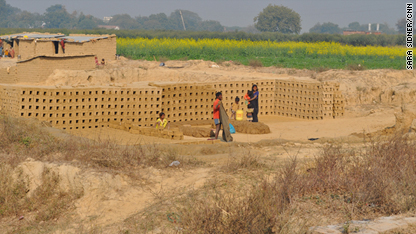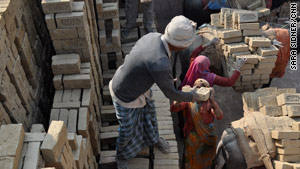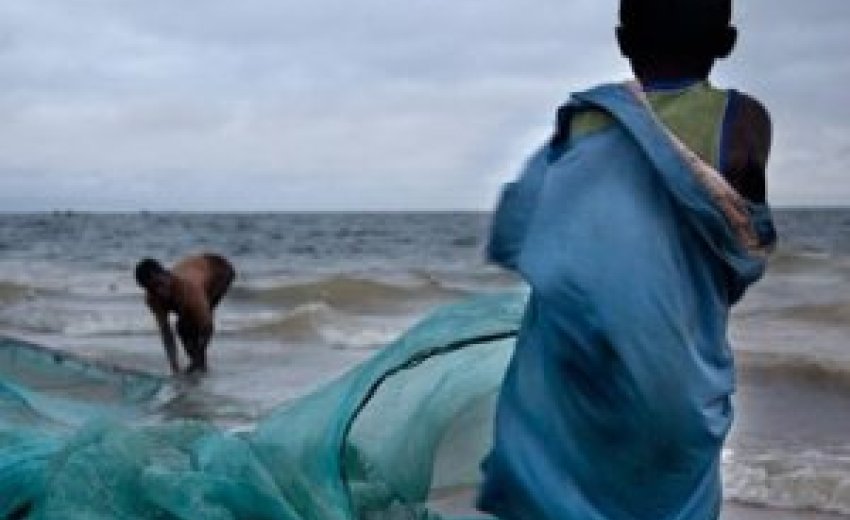March 8th, 2011 -Uttar Pradesh, India - An army of workers, their faces encrusted with dust, toils beside a story-high pile of unfired bricks. They are helping build a new India that appears to be leaving them behind. From sunup to sundown they spend their time pouring wet mud into molds, lugging them to the kiln, firing them and then pulling them out. For their backbreaking work, they do not receive wages.
They are working to pay off a debt.
In India they are known as bonded laborers, bound to those who gave them or their fore-fathers an advance or a loan. Human rights advocates call them modern day slaves.
"I cannot leave here unless I pay my debt," said Durgawati, a mother of three.
A contractor had approached Durgawati and her husband, offering them work in a far-off village. He had said there were plenty of opportunities and offered to pay an advance to prove it. Desperate to make a living and with no work in sight where they lived, they leapt at the chance and took the 1000-rupee ($22) advance, she said.
The contractor found them work, but now, the family said they were trapped.
"I have to make a thousand bricks per day," Durgawati said. "It's the most difficult thing. We are given big pieces of soil, then we have to break it. Then we make it into a dough. Then we knead the soil."
 |
| Durgawati and her family stand before piles of bricks, with their brick homes behind. |
She and her husband aren't the only ones in the family working. Their eldest daughter is nearly as fast as the adults at molding the earth into bricks. She is just five years old.
The family said they have not received wages since arriving three months ago. None of them has any idea how much they are owed. They said they have never been shown a balance sheet and couldn't read it anyway. They are illiterate and desperate to make a living.
They do get a small food allowance but say it barely feeds them. Still, the family wouldn't dare leave the worksite that doubles as their living quarters.
"They will beat me if I try to leave," Durgawati said.
Dozens of families are in the same predicament. They are all oblivious to the fact that bonded labor is illegal in India. The legislation has been in place for decades, but enforcement is lax.
"They have to work and repay the loan. They keep working," said Arun Singh, their supervisor. "We have an agreement."
He acknowledged that children are also working on the site, which would be a breach of India's child labor laws, even though he insists otherwise.
"Kids are working here for food. They need food. If they can't fill their stomachs, they need to work," Singh said.
Singh also asked CNN to pay for the interview. "Madam I charge, you pay me something," he said to no avail.
In another village, people have lived in bonded labor for generations.
"They remain in slavery forever," said Supriya Awasthi, South Asia director of Free the Slaves, a non-governmental organization dedicated to eradicating slavery around the world. "There are 27 million people around the world who are in slavery, and [the] maximum…live in India," she said.
According to estimates by policymakers, activists and scholars, the number of modern day slaves ranges from about 10 million to 30 million.
In the village of Dhomanpur a woman applied turmeric paste on the swollen foot of her husband, who said he had injured it when trying to get a cow off a truck for the landowner he works for.
"Even when I'm hurt or sick they call me to work. You won't believe how many atrocities I have to go through in a day," said Kharban Gagai, his leg hanging over his rope bed. The couple lives in a mud hut in a village owned by the landowner.
"When my father was alive he took an 8000-rupee ($175) loan from the landowner. Since that time I am having to work day and night for him," Gagai said, adding that he has never been paid. His father's debt changed his life. No matter who in the family borrowed money, that debt became his debt, Gagai said.
 |
| Workers hand bricks to another at a kiln in Uttar Pradesh, India. |
There are no physical signs the villagers are living in bondage: no chains, fences or armed guards, but the villagers say they are all slaves just the same.
"If I don't work, they will beat me. They will abuse my daughter," said Lalti, a mother of seven. "If you don't give in, they will sell your daughter or son."
Lalti said she had to borrow money from the landowner to treat her husband's tuberculosis years ago, and now she can't come and go as she pleases.
"I am an illiterate, so how would I know how much we owe, and what's left to pay? I don't even know how much we had taken. It's been many years."
As payment for work, she and her neighbors receive leftover food or bags of grain, Lalti said. They are beholden to the man who owns the land they live on.
None of them had heard of the Indian law that made bonded labor illegal more than 30 years ago.
"People in modern day slavery have no idea they can ever access any kind of rights," said Awasthi of Free the Slaves.
Lalti hopes she is able to work long enough so her children will be freed from the loan that binds her family to the land and a hard life.
"The day I pay my debt I will be free. We'll be prosperous," Lalti said.
Related Story:
This year CNN will join the fight to end modern-day slavery and shine a spotlight on the horrors of modern-day slavery, amplify the voices of the victims, highlight success stories and help unravel the complicated tangle of criminal enterprises trading in human life.
 |
|
Modern-day slavery: A problem that can't be ignored You know that moment when you read something, and then immediately have to re-read it because you cannot believe it is true? That happened to me when I read that the levels of slavery and people trafficking today are greater than at any point in history. Surely that cannot be right? Obviously there is no precise figure, but the International Labor Organization and respected abolitionists like Kevin Bales and Siddharth Kara put the global number of slaves at between 10-30 million worldwide. At a minimum, 10 million. Driving the global people trading business is ruthless greed, vast returns on investment and crucially, government ineffectiveness. The same as most criminal enterprises. And the numbers involved are extraordinary. The United Nations estimates the total market value of human trafficking at 32 billion U.S. dollars. In Europe, criminals are pocketing around $2.5 billion per year through sexual exploitation and forced labor. But let’s remember the commodity here is not drugs or contraband; it is human beings. And usually the most vulnerable in society. Those unable to defend themselves, those who innocently trust the intentions of others, those who can easily be made to disappear. The cruelty and inhumanity of those who would profit from such a crime is truly shocking. In previous centuries, when slaves were captured and traded each had a significant market value. Although their ill-treatment was often horrific, the reality was that it made economic sense to keep a slave alive and functioning, to protect what was usually a significant investment, made with a view to long term. That is not so today. Many girls and women, who are trafficked, particularly for the sex trade, are done so with a view to high rate of return over a relatively short period of time. Then they are switched from the steady supply of replacements. And what do you suppose happens to those who are seen to have maxed out their usefulness? Often addicted to drugs they have been forced to take, almost certainly in the country illegally, with no support, and with no record that they ever existed. A bad outcome is more or less assured. It is also difficult to see any hope for the people who trade in people. They have reconciled themselves to the awful crimes that they commit, and are unlikely to stop because others tell them to. No, to stop this shameful trade takes the will of governments. First in the countries where people are either abducted or forced into labor. These are often nations that are facing many problems, with tough economies, poor infrastructure, and sporadic and ineffective forces of law and order. People in rural and remote regions are often the targets, people who can be easily misled, or just kidnapped, with next to no chance of the crime ever being properly investigated. For local and national governments it is just one more of a series of pressing problems they must face. The international community has a role to play in forcing it higher up each of these countries to-do lists. This is not a problem that can be ignored. CNN will go to the places where the people traffickers ensnare their victims. And we will follow the routes through to markets where they get the best return on their haul. And these destination countries are often not those struggling with the basics of civil government and policing. No, they are established western societies, throughout Europe and in the U.S. Have you noticed when there are raids on the brothels in these countries, that when the police do a sweep of the red light areas, so many of those arrested appear to come from thousands of miles away? How did they get there? Is the so-called massage parlor operating in your neighborhood, sometimes brazenly touting the services of teenage Asian girls, really journey’s end for a wretched trip that began continents away? This is a story which truly touches many parts of the world. The current rates of return ensure that the people trafficking business will continue to grow, unless there is a concerted effort and will to stop it, by governments around the world. The UN’s Office on Drugs and Crime reports that human trafficking is the fastest growing criminal enterprise in the world – now tied with arms smuggling and trailing only the illicit drug trade. U.S. Secretary of State Hillary Clinton says human trafficking crosses cultures and continents. CNN will use the full range of our international resources to track and champion this story. We will be in the countries where people are abducted, traded and passed into the hands of the smugglers. We will follow the routes as people are ruthlessly moved to areas where they can generate the highest return on investment. And we will be at the end of the line where men, women and boys and girls are over-worked, raped and abused, and when no longer of value, discarded. It is a story which is shocking and tough. But there are also many examples of great courage and inspiration. Of people who have made a stand, of groups who at great personal risk have taken the fight to the criminals. And of individuals who have found freedom, and have not let their experience break them. We want to highlight these important victories, these triumphs of human spirit. There are many fine groups and individuals doing outstanding work to help trafficking victims. ?Organizations like Anti-Slavery International, Free the Slaves, International Justice Mission, ECPAT, Not For Sale and Polaris Project have fearless team members at the frontlines, risking their lives in lawless lands, to help those most vulnerable. Celebrities like Demi Moore and Ashton Kutcher, Ricky Martin, Anil Kapoor, Emmanuel Jal and Peter Gabriel are also dedicating their voices to the growing call for justice around the world. CNN will be proud to work with many of them as we put our resources behind this project throughout 2011. Because human trafficking is a shameful trade that must be stopped. |
Watch video below:

